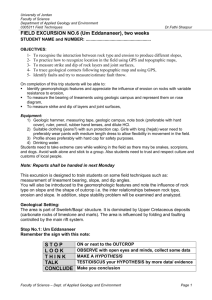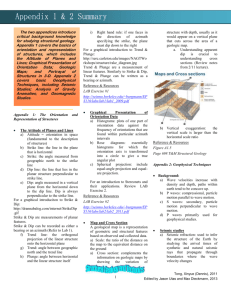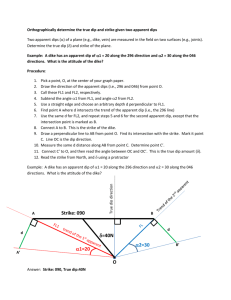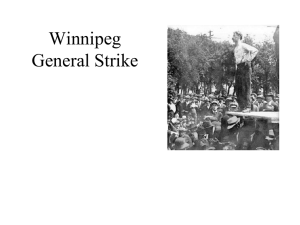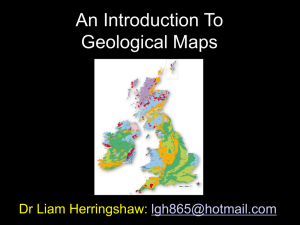STRUCTURAL GEOLOGY PRACTICAL 4
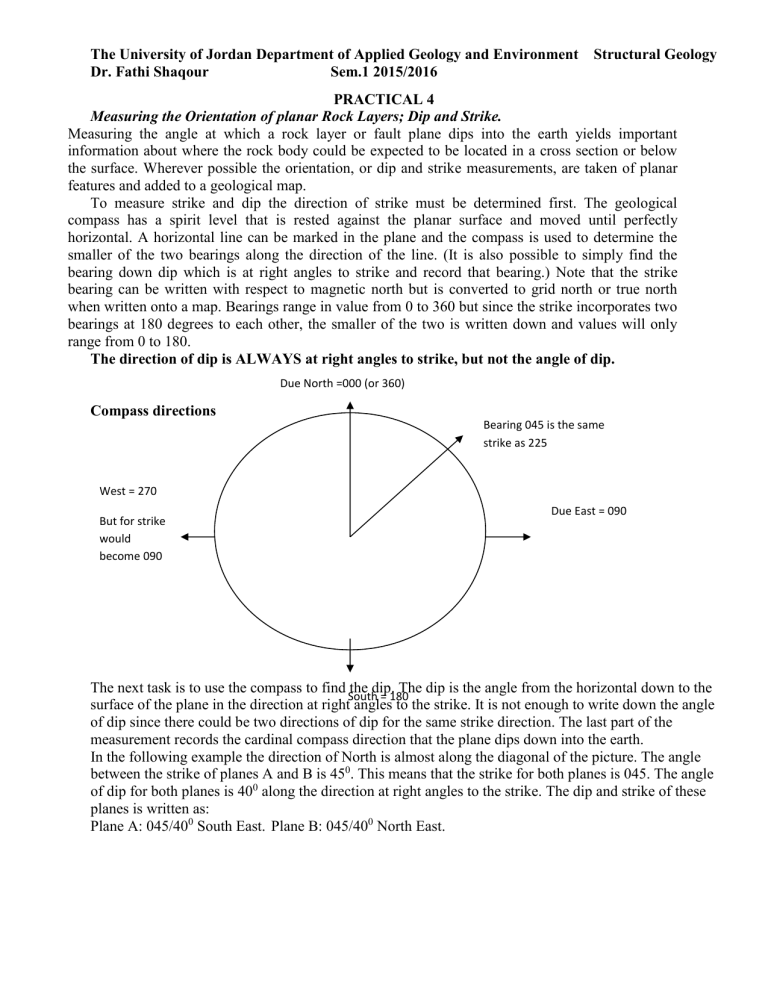
The University of Jordan Department of Applied Geology and Environment Structural Geology
Dr. Fathi Shaqour Sem.1 2015/2016
PRACTICAL 4
Measuring the Orientation of planar Rock Layers; Dip and Strike.
Measuring the angle at which a rock layer or fault plane dips into the earth yields important information about where the rock body could be expected to be located in a cross section or below the surface. Wherever possible the orientation, or dip and strike measurements, are taken of planar features and added to a geological map.
To measure strike and dip the direction of strike must be determined first. The geological compass has a spirit level that is rested against the planar surface and moved until perfectly horizontal. A horizontal line can be marked in the plane and the compass is used to determine the smaller of the two bearings along the direction of the line. (It is also possible to simply find the bearing down dip which is at right angles to strike and record that bearing.) Note that the strike bearing can be written with respect to magnetic north but is converted to grid north or true north when written onto a map. Bearings range in value from 0 to 360 but since the strike incorporates two bearings at 180 degrees to each other, the smaller of the two is written down and values will only range from 0 to 180.
The direction of dip is ALWAYS at right angles to strike, but not the angle of dip.
Due North =000 (or 360)
Compass directions
Bearing 045 is the same strike as 225
West = 270
But for strike
Due East = 090 would become 090
The next task is to use the compass to find the dip. The dip is the angle from the horizontal down to the
South = 180 surface of the plane in the direction at right angles to the strike. It is not enough to write down the angle of dip since there could be two directions of dip for the same strike direction. The last part of the measurement records the cardinal compass direction that the plane dips down into the earth.
In the following example the direction of North is almost along the diagonal of the picture. The angle between the strike of planes A and B is 45 0 . This means that the strike for both planes is 045. The angle of dip for both planes is 40
0
along the direction at right angles to the strike. The dip and strike of these planes is written as:
Plane A: 045/40 0 South East. Plane B: 045/40 0 North East.
The University of Jordan Department of Applied Geology and Environment Structural Geology
Dr. Fathi Shaqour Sem.1 2015/2016
Exercise 7.
Figure 8 is a geological map of an area of flat ground showing how a sequence of sedimentary strata intersects the surface. The measurements of dip and strike are included on the map. The small symbols ) ( e g. |- 90 ) indicate the strike and dip directions and angle.
Write the dip and strike of the sedimentary layers in the formal way.
When considering the ages of the rocks in the legend how can the rough contact between the conglomerate and the shale below it be accounted for?
Figure 8
A
On the blank section below, draw a cross section from A to B for the above map.
A
Ground surface
B
A
The University of Jordan Department of Applied Geology and Environment Structural Geology
Dr. Fathi Shaqour Sem.1 2015/2016
Folded Strata.
Exercise 2: The diagram below depicts two layers of sedimentary strata that were formed as horizontal layers and are now folded into a symmetrical, upright and parallel fold. Plane ABC is used in the next exercise. To this diagram add lables and lines to indicate each of the following parts of the fold structure: Anticline, Syncline, Hinge, Hingeline, Fold Axis and fold Limb.
Shade the strata in two distinct colours.
Figure 2
B
C
Imagine that the folds of figure 2 were eroded to a flat plane at the level of surface ABC. The strata would be exposed where they dip up to or down into the earth. Figure 3 shows how the outcrop pattern at the surface would appear. The outcrop for the two strata only are shown, in reality there would be other layers filling the empty spaces on the map. Shade in the two layers, add dip and strike symbols to the layers and draw lines to indicate where the hinge-lines of the anticline and syncline would be located.
A
X
The University of Jordan Department of Applied Geology and Environment Structural Geology
Dr. Fathi Shaqour Sem.1 2015/2016
C
B
Exercise 3: The diagram below is a cross section through X-Y for the map shown in figure 3.
The surface of the map area is flat. Sketch a cross section of the folded strata from the information given in the map.
Y
Surface
The University of Jordan Department of Applied Geology and Environment Structural Geology
Dr. Fathi Shaqour Sem.1 2015/2016
Figure 3
Exercise 4: The following map shows a sequence of sedimentary layers that are part of an upright folded structure. Sketch a cross section for the map from A to B in the box provided which assumes that the land surface is flat. Draw dashed lines to indicate where the folded layers would have been in the past above the present landscape before the area was eroded. Under the cross section list the rock types in order of their age from oldest to youngest.
Figure 4
The University of Jordan Department of Applied Geology and Environment Structural Geology
Dr. Fathi Shaqour Sem.1 2015/2016
A
Ground Surface
B
List of rock types in order of age:
Exercise 7. In many instances folds are not upright. The upright folds examined above all had fold axes, or hinge-lines that were horizontal. Folded strata can become subjected to further uplift and tilting or be folded again by forces from a different direction to those that caused the first wave of folding. As a result the old hinge-line will become tilted to the horizontal, or “plunge” into the earth.
The angle from the horizontal that a fold axis or hinge-line makes with the horizontal is called the plunge angle and the direction (measured as a compass bearing) that the hinge plunges downwards is called the trend.
Figure 6 A plunging anticline
Horizontal
Plunge angle
Fold Axis
Trend direction
The University of Jordan Department of Applied Geology and Environment Structural Geology
Dr. Fathi Shaqour Sem.1 2015/2016
When the plunging folds are eroded, the layers exposed at the surface will form a distinctive pattern of outcrops that allows interpretation of the folded structure of the rocks.
Figure 7 An eroded plunging syncline, left, and an anticline, right .
Use the strike and dip measurements of the map of Alderaan in Figure 8, to determine the location of synclinal and anticlinal hinge-lines. Draw in an axial trace and indicate the trend of the fold hinge-lines.
The University of Jordan Department of Applied Geology and Environment Structural Geology
Dr. Fathi Shaqour Sem.1 2015/2016
Figure 8
B
